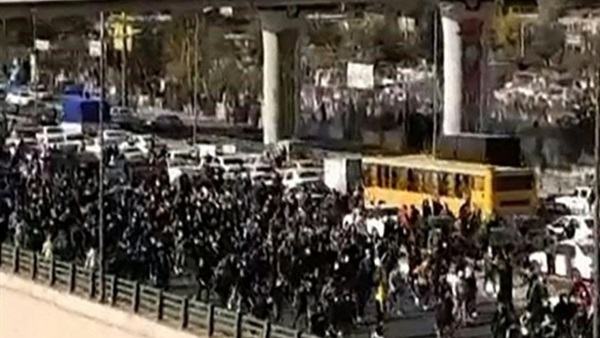Iran Issues First Known Death Sentence for Protester

An Iranian protester was sentenced to death for setting fire to a government building, the country’s judiciary said Sunday, the first known use of capital punishment by authorities seeking to suppress nearly two-month-old antigovernment demonstrations.
The death sentence opens a new phase in Iran’s attempt to use its legal system against mass protests that were sparked by the death of 22-year-old Mahsa Amini in police custody in September after she was detained for wearing attire the authorities deemed inappropriate.
Authorities say they have issued indictments of more than 1,000 people in Tehran alone, and on Sunday a judge in the southern province of Hormozgan said that 164 more protesters would be charged with a range of offenses, from propaganda to incitement to murder.
Authorities have struggled to quell the unrest that has occurred almost daily since Ms. Amini’s death. At least 330 people have been killed in the government’s response to demonstrations that began as a defiant call for women’s rights and have transformed into a movement calling for the toppling of the regime and political system.
Western governments have begun to step up pressure on Iran to temper its response to the protests.
Iceland and Germany are calling for a special session at the United Nations Human Rights Council over the situation in Iran, Iceland’s embassy in Geneva tweeted Friday. The meeting will “address the situation of women and girls in Iran in recent protests,” it said.
A spokesman for the council said a session on Iran’s response to the protests would be held the week of Nov. 21. More than 40 countries were supporting the request for such a session, the spokesman said.
The Human Rights Council move comes after human-rights experts working for the U.N. called on Iran to stop leveling charges that carry the death penalty against protesters. They called on the council “to establish an international investigative mechanism…to end the persistent impunity for grave human rights violations” in the country.
On Sunday, the unidentified defendant sentenced to death was charged with “war against God,” according to a statement by Iran’s judiciary news agency.
Also on Sunday, five other defendants, none of them named, were given five- to 10-year sentences for conspiracy to commit crimes against national security, as well as disruption of public peace and order, the statement said. The rulings by Tehran’s Revolutionary Court are subject to appeal. After final verdicts are issued the names of the convicted will be made public, it added.
At a press conference Tuesday, Masoud Setayeshi, a spokesman for Iran’s judiciary, said the treatment of detained protesters was lenient. “From the beginning of the riots, it was agreed to practice tolerance…so that the people distance their lines from the rioters,” he said.
Iran’s government on Sunday sent reports to foreign embassies defending its human-rights record, according to documents viewed by The Wall Street Journal.
Three reports sent from Iran’s Foreign Ministry laid out its claims that Ms. Amini’s death wasn’t caused by mistreatment from Iranian police. Instead, the reports blamed the U.S. and other governments for fomenting the unrest.
“Certain European countries and the United States intervened and supported the rioters by openly interfering in Iran’s internal affairs,” one of the reports read. “The Islamic Republic advises the human rights mechanisms to observe impartiality, fairness and professionalism and refrain from entering into the political agenda of certain countries.”
The Foreign Ministry said in one of the reports that hundreds of ATMs, ambulances, police motorcycles, fire engines and religious sites had been burned and destroyed in “organized attacks.” Another described the government’s response to unrest at Tehran’s Evin prison, where guards clashed with prisoners on Oct. 17, saying it complied with international standards
The Committee for Follow-Up on the Status of Detainees, a transnational group that tracks political detentions in Iran, said it had identified 42 journalists and 65 children who had been arrested for their participation in the protests, in a report published Friday. Among the indicted, nine people were accused of “being an enemy of God” and “corruption on earth,” two charges that can carry the death penalty, the committee said.
Javaid Rehman, the U.N.’s special rapporteur on the situation of human rights in Iran, said the country’s investigations into protesters and the use of its legal system “had failed to meet the minimum standards of transparency, objectivity and impartiality.”
Some protesters were taken from their home at gunpoint by plainclothes members of Iran’s Islamic Revolutionary Guard Corps without warrants and kept incommunicado for weeks, according to the Committee for Follow-Up on the Status of Detainees.
One prisoner told the committee that he was taken in the trunk of a car and detained at an underground facility near Kolahdooz, north Tehran, the committee said in its report. Interrogators at Evin prison forced female protesters in their custody to stand naked and threatened to release private pictures of prisoners to the media or to carry out sexual assaults on detainees, according to testimonies received by the committee. “If you are raped here, you cannot protest!” one investigator told a female detainee, according to one testimony.
“Authorities subject detainees to mistreatment, torture and coerced confessions,” said Tara Sepehri Far, a researcher at New York-based Human Rights Watch. “The trials fall grossly short of fair trial standards.”





